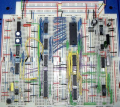I am given a school project where i have to design a mod 60 counter with start/stop and reset functions on a digital trainer breadboard circuit using two 4-bit binary counter IC chips (74LS93). I am also able to use other basic logic gates such as NAND, NOT, AND and OR gates to construct my circuit. I successfully simulated this counter using the software multisim. (picture and file of counter will be attached). However, as i attempt to construct this counter on my actual hardware breadboard circuit. I encountered a problem. Initially I had success in constructing a mod-60 counter that counts from "00" to "59" before resetting to "00" when it reaches 60. I also managed to successfully implement the second part successfully, a button when pressed can start/stop the counter circuit. For example, if i pressed the start/stop button the 7-segment LED display would stop counting upwards and whenever the counter circuit successfully complete counting one cycle, I can press the start/stop button to resume counting when the LED 7-segment display remains at "00". However, at the third part, which is implementing a reset button function is where i failed at. As simulated in my file, when the reset button is pressed LED 7-segment display is supposed to reset to "00" regardless of what the number was displayed on the 7-segment display initially was. Howver, as implemented this circuit and following my own configurations in my multisim simulation file, the counter reset and start/stop function works completely fine. The problem is that the counter when it counts up to "10" it stops and I have to press the start/stop button for it to continue counting and when the circuit counts up to 20, it resets to "00". The circuit I designed was supposed to count up to 60 and have it reset to "00". Does anybody know of any possible wiring errors or possible mistakes I could have made because I'm not sure what the error is or how to troubleshoot it. I need help.
Attachments
-
202.1 KB Views: 56
-
163.6 KB Views: 30
-
245.8 KB Views: 25
-
191 KB Views: 22
-
285 KB Views: 23
-
198.8 KB Views: 24
-
261.9 KB Views: 26


















